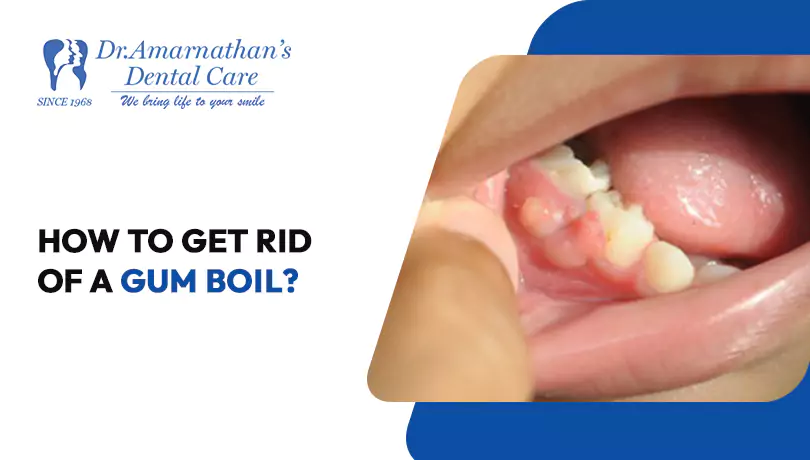
How to get rid of a gum boil?
A gum boil, also known as a tooth abscess, is a troubling dental condition that can cause substantial discomfort and worry. These painful swellings, which are usually caused by gum or tooth infections, may be a source of stress for many people, making it difficult to eat, speak, and maintain oral hygiene. Understanding how to treat a gum boil correctly is essential not just for relieving discomfort but also for avoiding subsequent complications that might lead to more serious dental problems.
In this blog, we’ll look at the cause of gum boils, efficient home remedies, dental treatments, and preventative steps to help you restore your oral health and well-being. Whether you’re dealing with a gum boil for the first time or looking for solutions to handle recurring problems, this blog will give helpful insights to aid you in recovery.
What is a gum boil?
A gum boil, sometimes called a periodontal abscess, is an infection in the gum tissue that causes a pus-filled lump on the gums. It is usually caused by bacterial infections that are associated with poor oral hygiene, periodontal disease, or deep dental cavities. Gum boils can be painful and result in swelling, redness, and sensitivity in the afflicted region. Prompt treatment is necessary to avoid future consequences.
Causes of Gum Boil:
Poor oral hygiene: Inadequate brushing and flossing can cause plaque accumulation, which holds germs and raises the risk of illness.
Periodontal Diseases: Advanced gum disease causes pockets between the teeth and gums, which can get infected and result in abscesses.
Dental cavities: Deep cavities can allow germs to enter the pulp of the tooth, causing infections that spread to the gums.
Injury to the gums: Trauma to the gum tissue, such as forceful brushing or dental operations, can introduce germs and lead to infection.
Weakened Immune System: Diabetes and immune-suppressing drugs might make people more susceptible to infections, including gum boils.
Impacted Food Particles: Food trapped between teeth and gums decomposes and attracts germs, resulting in an abscess.
Failed Dental Work: Poorly fitted crowns, bridges, or fillings can leave spaces for bacteria to grow and cause infections.
Symptoms of Gum Boil:
- Redness and swelling in the gums.
- A noticeable lump or pimple on the gum.
- The afflicted region is painful and sensitive.
- Pus discharge from the bump.
- Bad breath or a bad taste in your mouth.
- Heightened sensitivity to hot or cold meals and beverages
- Fever in serious situations
- Trouble eating or swallowing
How to get rid of a gum boil?
Dental Treatment for Gum Boil:
1. Drainage of Abscess
Procedure: The dentist will make a tiny incision in the gum to drain pus from the abscess. This method lowers pressure, minimizes discomfort, and speeds up recovery.
Aftercare: Post-procedure care involves maintaining oral hygiene, using recommended mouth rinses, and maybe taking antibiotics to avoid infection.
2. Deep Cleaning
Scaling and root planing: These procedures thoroughly clean the teeth and gums. Scaling eliminates plaque and tartar accumulation beneath the gumline, and root planing smoothes the root surfaces, allowing the gums to reconnect and recover.
Benefits: Deep cleaning helps to address the underlying cause of the illness, especially if periodontal disease is present.
3. Root Canal Therapy
Indication: If the infection has gone to the tooth’s pulp (the inner tissue), a root canal may be required.
Procedure: The dentist will remove the infected pulp, clean and disinfect the root canals, and then fill and seal them. A crown can be put on a tooth to restore its function and appearance.
Outcome: This surgery aims to eradicate the cause of illness while preserving the tooth.
4. Antibiotic therapy
Prescription: Depending on the severity of the illness and if it has spread, your dentist may recommend antibiotics.
Purpose: Antibiotics assist in removing bacterial infections and keep them from spreading beyond the gum region.
5. Restorative treatments
Addressing Decay or Damage: If the gum boil is caused by dental decay or broken restorations, your dentist may prescribe fillings, crowns, or other therapeutic procedures to address the problem and avoid a recurrence.
6. Follow-up Care
Monitoring: Regular follow-up sessions will be organized to check healing and confirm that the infection has been completely cleared.
Oral Hygiene Advice: Your dentist will advise you on how to maintain proper oral hygiene and avoid future problems.
Home Remedies to Get Rid of a Gum Boil
Salt Water Rinse: To minimize germs and inflammation, mix a teaspoon of salt into a glass of warm water and rinse several times each day.
Hydrogen Peroxide Rinse: Dilute hydrogen peroxide in equal parts water and use it as a mouthwash to disinfect the region.
Cold Compress: Use a cold compress on the outside of your cheek to minimize swelling and discomfort.
Clove Oil: For natural pain relief and antimicrobial characteristics, apply a tiny quantity of clove oil directly to the gum boil.
Preventive Measures for Gum Boil:
Maintain good oral hygiene: Brush your teeth twice a day with fluoride toothpaste and floss every day to eliminate plaque and food particles that can cause infections.
Regular Dental Checkups: See your dentist every six months for expert cleanings and checkups to discover and treat problems early.
Healthy Diet: Eat a well-balanced diet high in vitamins and minerals, and minimize sugary foods and beverages that can lead to cavities and gum disease.
Avoid Tobacco Products: Smoking and using other tobacco products can aggravate gum disease and increase infection risk.
Prompt Dental Treatment: To avoid complications, treat any indicators of dental issues, such as cavities or gum disease, as soon as they appear.
Use Antiseptic Mouthwash: Add an antiseptic mouthwash to your regular schedule to help minimize germs in your mouth.
Conclusion:
Dealing with a gum boil can be difficult and upsetting, but with immediate care, the disease can be efficiently managed and treated. While home cures may provide temporary comfort, professional dental care is required for a complete recovery and to address any underlying concerns. By practicing proper dental hygiene and taking preventive steps, you may avoid future gum boils and keep a healthy, pain-free smile. If you feel you have a gum boil, contact your dentist to determine the best plan of action.




